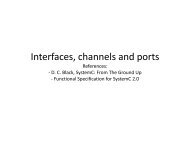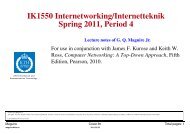An Overview of the PKCS Standards
An Overview of the PKCS Standards
An Overview of the PKCS Standards
Create successful ePaper yourself
Turn your PDF publications into a flip-book with our unique Google optimized e-Paper software.
Page 16<br />
ERROR! STYLE NOT DEFINED.<br />
The reason that <strong>the</strong> "outer" content type must be signedData is that <strong>the</strong> "inner"<br />
content must be presented in <strong>the</strong> clear, since encrypted content in <strong>PKCS</strong> #7 is different<br />
than encrypted content in X.400. The latter encrypts a complete BER encoding, and <strong>the</strong><br />
former encrypts only <strong>the</strong> contents octets.<br />
Compatibility with X.400 is achieved by placing an X.411 message token among <strong>the</strong><br />
unau<strong>the</strong>nticated attributes for <strong>the</strong> signer <strong>of</strong> <strong>the</strong> <strong>PKCS</strong> #7 data. Computing <strong>the</strong> X.411<br />
message token involves ano<strong>the</strong>r private-key operation with <strong>the</strong> signer's private key in<br />
addition to <strong>the</strong> one for computing <strong>the</strong> signer's encrypted message digest already required<br />
by <strong>PKCS</strong> #7, so X.400 compatibility is not efficient.<br />
5.3.2 Fur<strong>the</strong>r compatibilities<br />
Since <strong>the</strong> md2WithRSAEncryption and md5WithRSAEncryption signature<br />
algorithms in <strong>PKCS</strong> #1 are consistent with <strong>the</strong> SIGNED and SIGNATURE macros, as<br />
discussed in Section 5.2.2, those algorithms can be used in computing <strong>the</strong>se X.411<br />
quantities: content-integrity check; message origin-au<strong>the</strong>ntication check; and asymmetric<br />
token.<br />
5.4 Draft network-layer and transport-layer security protocols<br />
<strong>PKCS</strong> is compatible with <strong>the</strong> draft standards for security in <strong>the</strong> network and transport<br />
layer [ISO90a][ISO90b]. Specifically, <strong>the</strong> dhKeyAgreement algorithm in <strong>PKCS</strong> #3 can<br />
be used in ei<strong>the</strong>r <strong>of</strong> those draft standards.<br />
5.5 DSS and SHS<br />
<strong>PKCS</strong> is partially compatible with NIST's proposed Digital Signature Standard (DSS).<br />
<strong>PKCS</strong> #6 extended certificates may be signed with DSS, but since DSS signatures do not<br />
include a <strong>PKCS</strong> #7 DigestInfo value, <strong>the</strong>y are not compatible with <strong>PKCS</strong> #7.<br />
<strong>PKCS</strong> is compatible with <strong>the</strong> Secure Hash Standard (SHS), which can be used as a<br />
message-digest algorithm in <strong>PKCS</strong> #7.<br />
5.6 ISO/IEC 9796<br />
<strong>PKCS</strong> is only partially compatible with <strong>the</strong> ISO/IEC standard digital signature scheme<br />
giving message recovery. <strong>PKCS</strong> #6 extended certificates and <strong>PKCS</strong> #7 signed-data<br />
content may be signed according to ISO/IEC 9796. However, <strong>PKCS</strong> #1 is not compatible,<br />
as <strong>the</strong> RSA encryption block format in <strong>PKCS</strong> #1 is different than <strong>the</strong> format specified by<br />
ISO/IEC 9796.

















